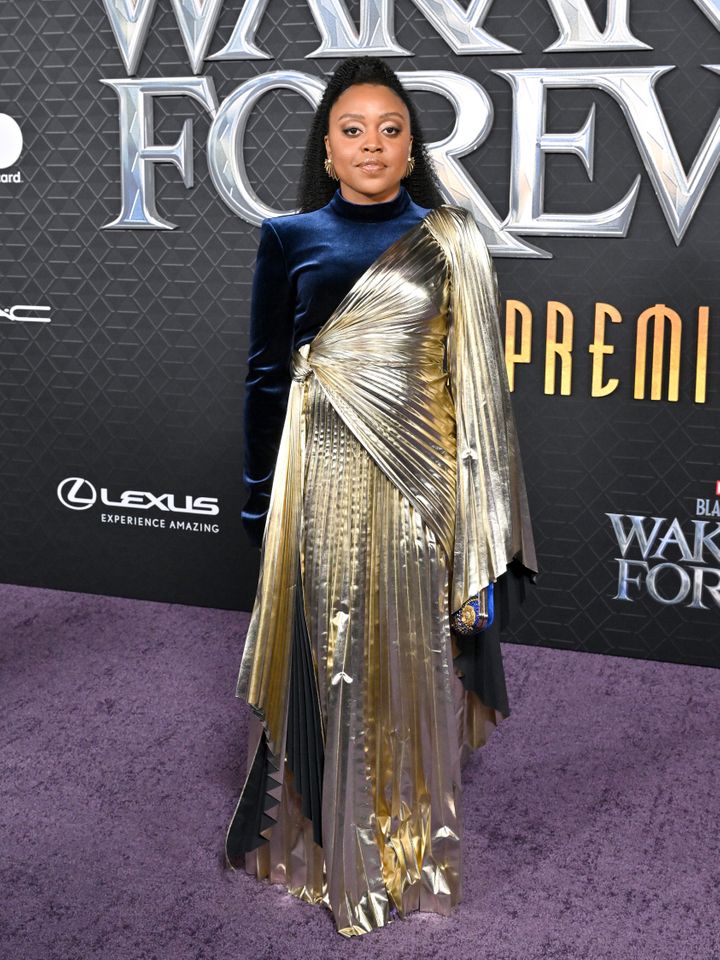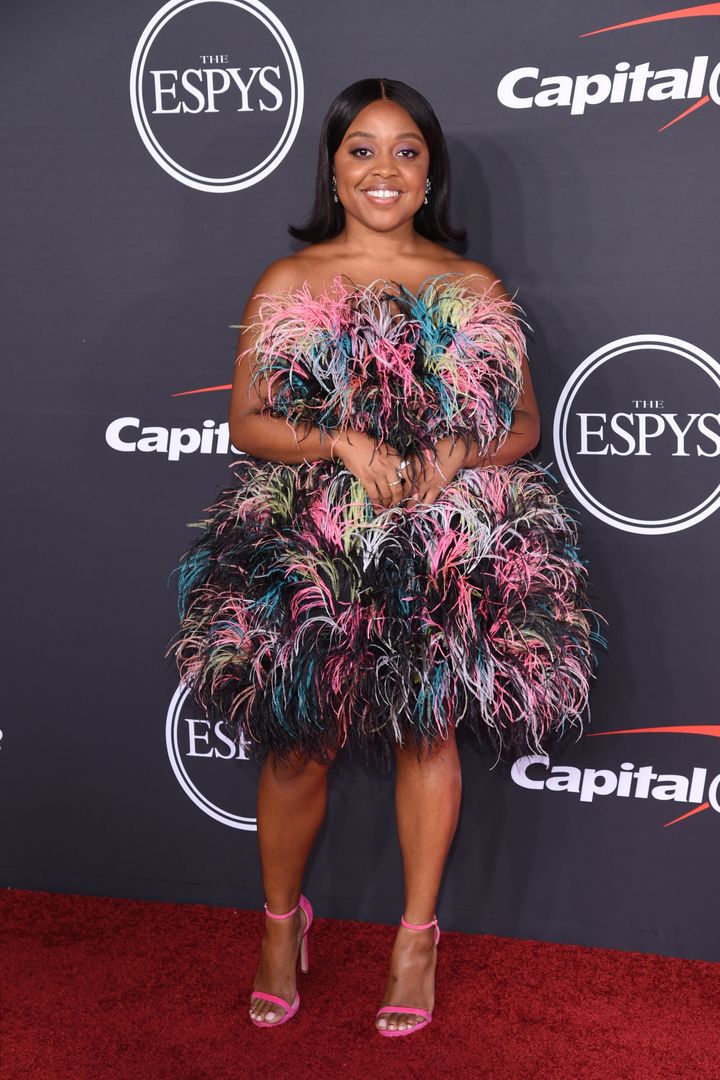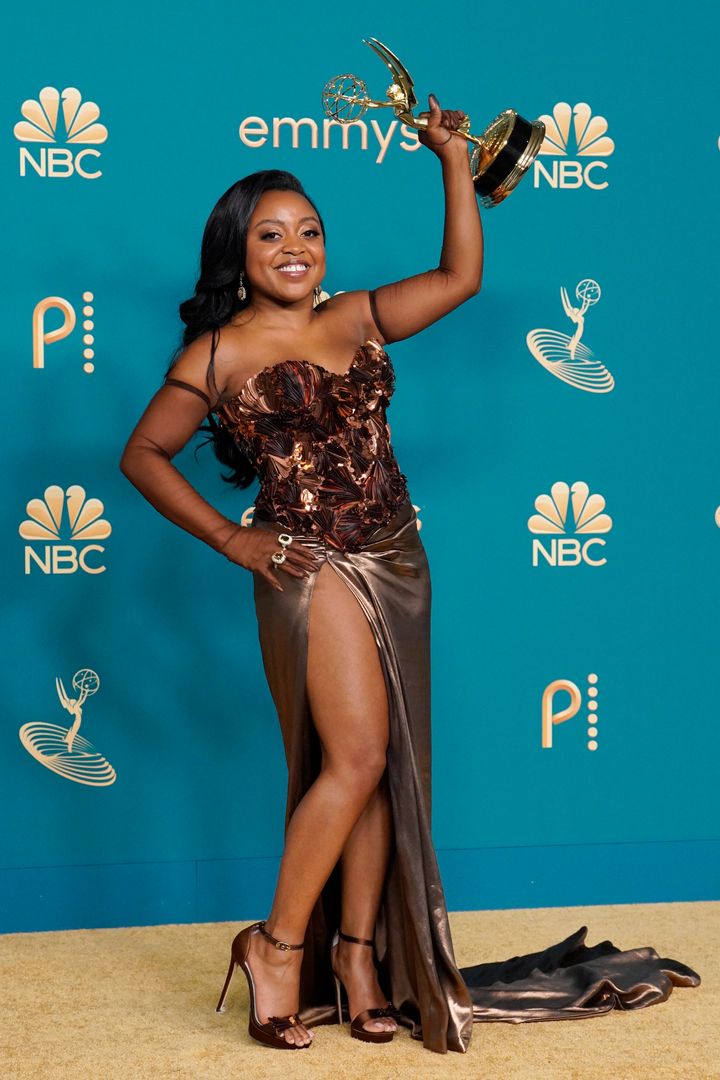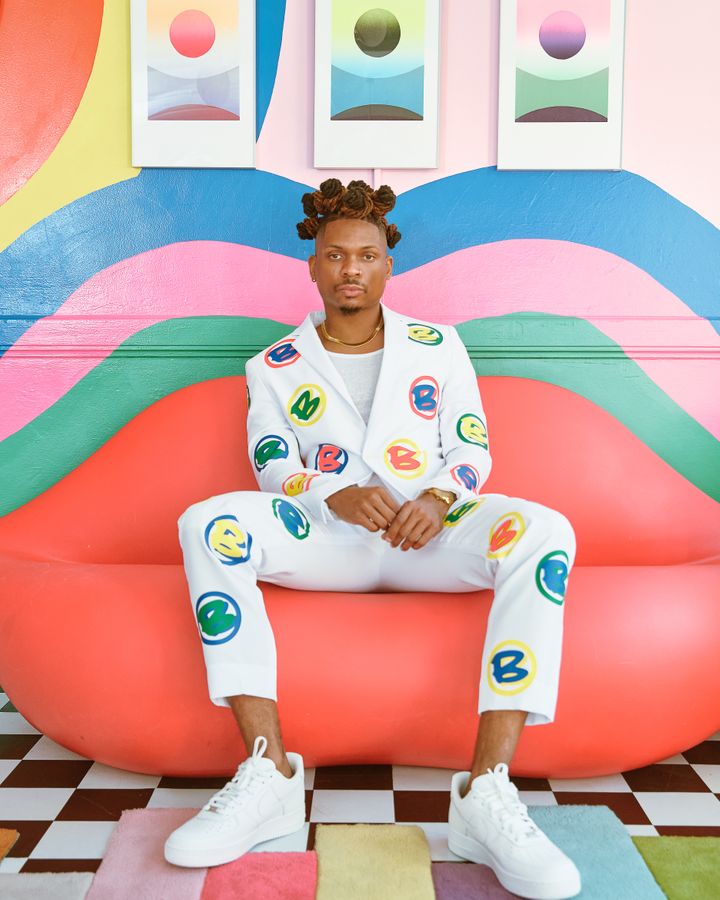The glitz and glamour of entertainment is nothing without the people who dress today’s biggest stars. For “Who’s Behind the Clothes,” HuffPost spotlights stylists and costume designers who have delivered some of our favorite celebrities’ or characters’ most memorable looks. Read my interview with “Black Panther” costume designer Ruth E. Carter.
Celebrity stylist Bryon Javar has developed an arsenal of clientele: Marsai Martin, Karreuche Tran, Miami rap duo The City Girls, Niecy Nash and “Abbott Elementary” star Quinta Brunson. Javar, born and raised in Compton, California, began styling in high school, determined to enter the industry despite the 2008 financial crisis.
Now Javar, 32, has been in the game for 14 years. The youngest of three siblings, he attributes his love for style to his older sisters — and watching the 1993 film “What’s Love Got to Do With It.” The movie ignited a flame in him that couldn’t be extinguished.
“As I got older, obviously, I understood that that was fashion,” Javar said. “Since then, I didn’t know if I wanted to be a designer, jewelry designer, but I just knew something in fashion was for me.”
Javar started as a visual merchandiser at Forever 21, then, heeding the advice of style idols such as June Ambrose, Misa Hylton and Tameka Foster, he sought out internships. After years of mentorship under Lor-e Phillips, stylist for the Black Eyed Peas, he branched out independently in 2015. His first major moment? Styling friend and actor Karreuche Tran for the 2015 BET Hip Hop Awards.
“I was like, ‘Give me a chance, let me create something and take it to the next level for you.’ And she gave me the opportunity,” Javar said. “That was the beginning of it for me, where I felt like I was taken seriously the first time as a stylist.”
Since then, Javar has turned Brunson, our favorite internet cousin, into a fashion fiend and brought Black starlets like Martin into the red carpet spotlight. As he embarks on his first shoe line, Javar talked to HuffPost about how his first layoff was a blessing in disguise, why Black women are his muses and styling outside the lines.
You’ve styled Tracee Ellis Ross and Marsai Martin’s Ebony cover in March, Jessica Williams for Essence and so many other starlets. Is there a particular cover or project that stood out to you as your favorite styling moment, and why?
One of my favorite styling moments was Marsai and Tracee’s cover shoot for Ebony. For me, it was beautiful and colorful. I feel like it was her coming into her own, where it helped everyone not look at her as the young kid from “Black-ish.” Now people are looking at her as a young woman. The Pamella Roland dress that I put Quinta in for People magazine, it was like a feather dress with this train. It was just beautiful and stunning. I love that because Quinta’s 4 foot 11, and I’ve been able to make her seem not so short — and enter the chat as a new fashion girl. That’s something I love and appreciate, me being able to pay attention to detail when it comes to my clients on what works for them or what doesn’t.
I remember you did an interview with Essence talking about the importance of platforming Black designers in your work. I also noticed that you work on a lot of Black women and Black femmes. Are Black women your muses, and what does it mean to you to be styling us?
Black women, I love styling because I’m looking at my sisters, my mom, my cousins, my niece and things like that. I love being able to show the world what we’ve already known and what we’ve already seen but also styling different body types, different skin tones and showing the beauty that is within us, no matter if someone’s a size zero or if they’re a size 16. It’s being able to show and push to the forefront that we are beautiful beings; if we have no curves or if we have major curves, no matter what, we make something work, and that shit is going to look beyond amazing and effortless. It is one of my favorite things to do that just so happens to be my job and my career choice. I love being able to make a woman in general feel good, especially a Black woman. It just does something to me when a Black woman feels amazing.
Who are some of your personal favorite designers, and why? What brands do you frequent when it comes to styling?
I love Sergio Hudson, Christopher John Rogers and Aliette, three of my favorite designers who happen to be Black designers as well. I also love Prabal Gurung. They’re fucking phenomenal. Brandon Maxwell I’m obsessed with.

Axelle/Bauer-Griffin via Getty Images
Tell me a little about your journey to costume design. Who inspired you to enter the industry?
I’ve been in styling and fashion in general for a very long time. My first introduction to fashion was watching the movie “What’s Love Got to Do With It?” and just seeing how iconic Ike Turner and Tina Turner’s looks were. As a 4-year-old, I just was very intrigued why they looked so different from everyone else. As I got older, obviously, I understood that that was fashion. Since then, I didn’t know if I wanted to be a designer, jewelry designer, but I just knew something in fashion was for me. I remember watching an interview on BET, and it was when one Usher’s “Confessions” albums came out, and his stylist at the time, Tameka Foster, was just talking about what she does, how much she makes and what the job entails. I was like, “Wait, that seems like something that I’m into.” I remember googling stylists, and it was her, June Ambrose and Misa Hylton that came up. I studied them for years: what they did, the work that they created and how to get into the industry. Most of them said, “Internships, internships,” so shortly after high school, I got an internship with Lor-e Phillips, who was the Black Eyed Peas’ stylist, and that changed my life.
Tell me about those internships you had, then the moment you decided to stand on your own as an independent, solo stylist.
I worked with Lor-e Phillips, who was the Black Eyed Peas’ stylist. That was a dive in, because I thought it was just going to be running, getting coffee and blah, blah, blah. I remember my second day on the job, I was assisting for the “Boom Boom Pow” video, so it was the last era of the album “The E.N.D.” and it was very hands-on. I call Lor-e a fairy godmother because she took me under her wing and taught me everything from costume designing to styling, how to properly style a commercial, a music video, an editorial shoot or how to prepare for a world tour. There were so many things that I’ve learned from her very early on that sometimes people don’t get to experience at all. With her, I was able to learn, honestly, about everything in the industry. After that, I worked with stylist Bec Gross, and I learned a little bit more about red carpets with her and commercial campaign shoots. Then I was also working at Forever 21 as a visual merchandiser, so in the midst of all of that, I was still working full time. I ended up getting fired from Forever 21; in that moment, I was like, “OK, it’s time to take things up a notch” and go about things my way, be solo and not be anyone’s assistant or intern.
After being fired at Forever 21, were you concerned about being blacklisted?
Honestly, truly, when that happened, I knew that I had been needing to leave the company for maybe two years. It was nothing but God saying, “Your time has come here. I’m pushing you out. It’s time for you to soar and stop minimizing your talents and realize that your talents can go beyond these four walls.”

Jon Kopaloff via Getty Images
2008 was the recession; it was a very precarious time. Were you ever nervous or unsure about your abilities, or more determined to enter the industry full force?
I was never nervous. I definitely had moments where I’m like, “Is this gonna work?” But I was never nervous because I just knew what plan I had and what God said. I just knew that somehow, some way, it would all work out in my favor, whether it was in the earlier years or later years. But I knew that, at some point, something was going to give, and it was going to be worth it.
How would you characterize or describe your personal sense of style, and how has your upbringing in Compton influenced it? Who were some of your earliest style icons?
Would definitely say my sisters. My mom had me when she was 42, and my sisters were already out of high school, so they’re 19 and 20 years older than me. They were always my first influence when it came to fashion. One was a little bit more of the rebel: crop tops, short shorts and body piercings. The other one was a little bit more modern, kind of like Nia Long or Jada Pinkett vibes. My first inspiration was watching them growing up and just always being into fashion and how to present yourself to the public.
As for my personal style, honestly, I don’t even have a word for it. I don’t think I’m searching for anything. It’s just been about going with the flow. I’ve been loving baggy jeans and baggy sweats; I love oversized band T-shirts. I’m gonna go with the flow, with what’s comfortable. Coachella vibe, but make it every day, if that makes sense.

New York City has long been regarded as fashion’s epicenter, so coming from Compton, did you find it difficult to break into the industry? What are some obstacles that you encountered upon first starting your career, be it access to archival pieces or building a client base?
Learning the business part of it. I learned that I have always been talented when I can put an outfit together for someone. Things that are more important, or just as important in business, [are] your contacts, how to properly invoice, how to properly price your rates, how to set up when you need an intern or an assistant, and how to market. The learning curve for me was learning the business aspect of everything versus thinking that it was just putting clothes on people.
You’ve touched on how various mentors and bosses have instilled different skills in you. Can you walk me through the process of discerning different celebrities’ style needs, be it for cover shoots, late-night show appearances or red carpets? In other words, explain how you work with such broad tastes to get a desired result every time.
Some of my clients throw their hands up and let me do me, and some of them are very detailed and very specific about what they want. Quinta is very easy. She doesn’t fight me on much, but when she does, I’m like, “OK, you know what, let me not give any pushback,” because there’s very few times where she’s like, “No, I don’t want to wear this type of color.” My process depends on the client. With Marsai, we’ll text about ideas: Are you feeling young and fresh or do you want to go a little bit more grown and sexy, want to do a little rock ‘n’ roll or tomboy chic kind of vibe? We vibe off of that first, then that helps me and motivates me to have an idea of what it is that I’m going for. If we’re doing customs, my clients allow me to come up with the ideas. By the grace of God, if they love it, we’ll just move forward unless there’s a lot of input that they have.
Speaking of Quinta, you styled her in this excellent gilded look for the Emmys — but it was Dolce & Gabbana, a brand that has a contentious track record with our community and longstanding history of racism and homophobia. Do these things affect your styling decisions?
Unfortunately, there have been countless brands that have done very wrong and fucked up things. I think what helps me is when I see a brand try to right their wrongs when they appoint certain people in positions to help inform them of their ignorance and how to move forward. Whether it’s a tissue company that we’re using or if it’s a shoe brand, most brands have had very not OK things happen. It takes a while for me. I have to see the work and what it is that they’re trying to do, the objective to help right their wrongs.

Evans Vestal Ward/NBC via Getty Images
How do you keep up with the cyclical nature of fashion and trends while pushing the needle and putting your own spin on it? I feel like one of the hardest parts of the role is making sure that you’re doing something unique with each client.
For me, I just have my own way of making something work for the client. I have a few clients that may be the same sizes. If one dress doesn’t work for this client and I can try for the next one, I might add a glove, a hat or a stocking. If I had it with a pump with the other client, I can do a boot, where it’s something that’s more personalized for them and not just something that anybody can wear. [I want] to really pull out what their personality and their energy is, not just put something on someone. I don’t necessarily like to go with a trend; I just kind of go with things that work for my clients’ body types, their height, their skin tone, their cup size and things like that. I like to just make things more personalized to them that work versus going with a trend that satisfies the masses.
Tell me a little bit about how you coined your hashtag #TheRulesAreSimple.
It’s so funny, I was just talking about this. I was either in-person or on the phone talking to a friend — and I’m a jokester, just talking shit is what I do — and I remember somebody asked me something. I think they asked about wearing all white after Labor Day, like “Isn’t that a fashion rule?” And I was like, “What rule? Who listens to rules?” They were like, “Aren’t there rules of fashion?” And I said, “The rules are simple. You do whatever you want to do, whatever works for you, whatever floats your boat.” And it just stuck with me in it. That’s how I came up with that concept.
Do you have a dream client you’d love to add to your roster?
This always gets tricky. [laughs] I have to answer this very carefully. One day, I’d love to style Michelle Obama, Jill Scott and Beyoncé.
Where do you see your journey going next?
I have a shoe collab coming out with shoe designer Jessica Rich, and that’s going to come out in November. That’s something I’m really excited about, stepping into designing women’s shoes and also doing more creative directing work.

